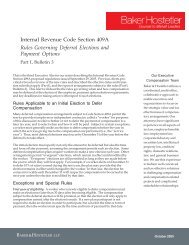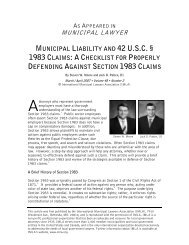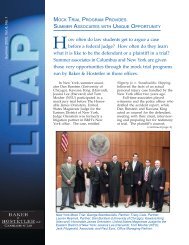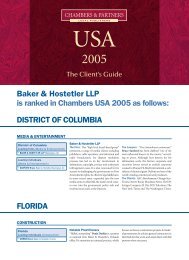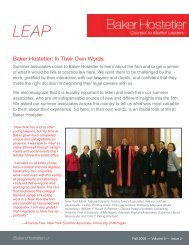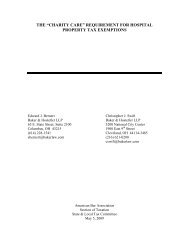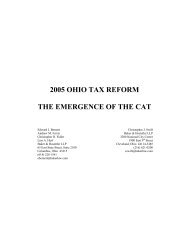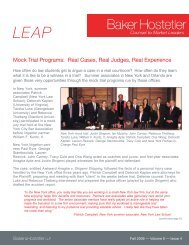Prejudgment Remedies in Texas - Doug D'Arche - Back to Main Page
Prejudgment Remedies in Texas - Doug D'Arche - Back to Main Page
Prejudgment Remedies in Texas - Doug D'Arche - Back to Main Page
- No tags were found...
Create successful ePaper yourself
Turn your PDF publications into a flip-book with our unique Google optimized e-Paper software.
necessarily delayed <strong>to</strong> ensure that writ serves its <strong>in</strong>tended purpose -- <strong>to</strong> 'trap' funds belong<strong>in</strong>g <strong>to</strong>the [Deb<strong>to</strong>r] but <strong>in</strong> the hands of a third party. In re L.A.M. & Associates, 975 S.W.2d 80, 84(Tex. App.—Aust<strong>in</strong> 1998 no writ).One Court of Appeals has held that the Deb<strong>to</strong>r's participation <strong>in</strong> the Garnishmentproceed<strong>in</strong>g waives service of a copy of the writ. DEL-PHI Eng<strong>in</strong>eer<strong>in</strong>g Associates, Inc. v. <strong>Texas</strong>Commerce Bank-Conroe, N.A., 771 S.W.2d 589, 591 (Tex. App.—Beaumont 1989, no writ).Other Courts of Appeal have held that an appearance by the Deb<strong>to</strong>r does not waive the noticerequirement under Tex. R. Civ. P. 663a. Walnut Equipment Leas<strong>in</strong>g Co. v. J-V Dirt & Loam, aDiv. of J-V Marble Mfg., Inc., 907 S.W.2d 912, 915 (Tex. App.—Aust<strong>in</strong> 1995, writ denied);Mendoza v. Luke Fruia Investments, Inc., 962 S.W.2d 650, 652 (Tex. App.—Corpus Christi1998, no writ); Small Bus. Inv. Co. of Hous<strong>to</strong>n v. Champion Int'l Corp., 619 S.W.2d 28, 30 (Tex.Civ. App.—Hous<strong>to</strong>n [1st Dist.] 1981, no writ). These Courts have held that when a Deb<strong>to</strong>rvoluntarily answers and appears <strong>in</strong> a Garnishment proceed<strong>in</strong>g, the Deb<strong>to</strong>r waives onlyirregularities <strong>in</strong> the Garnishment, such as defects <strong>in</strong> the affidavit or bond. Id. Voluntaryappearance does not waive the requirements of the writ itself. Id. Under this l<strong>in</strong>e of cases, nocontrol or cus<strong>to</strong>dy of a Deb<strong>to</strong>r’s property can be ga<strong>in</strong>ed by his answer if he has not beenproperly served. Id.The Garnishee lacks stand<strong>in</strong>g <strong>to</strong> assert the failure of the Credi<strong>to</strong>r <strong>to</strong> serve a copy of thewrit on the Deb<strong>to</strong>r. Sherry Lane Nat. Bank v. Bank of Evergreen, 715 S.W.2d 148, 151 (Tex.App.—Dallas 1986, writ ref'd n.r.e.).10. Garnishee's Response <strong>to</strong> a Writ of GarnishmentThe garnishment action is technically a lawsuit that has been filed aga<strong>in</strong>st theGarnishee. The Garnishee's response is governed by the <strong>Texas</strong> Rules of Civil Procedureunless specifically modified by the chapter deal<strong>in</strong>g with garnishments. Generally, theGarnishee's answer is due on the Monday follow<strong>in</strong>g 20 days after the writ has been served(except <strong>in</strong> Justice Court where<strong>in</strong> the answer is due on the Monday follow<strong>in</strong>g 10 days after thewrit has been served). TEX. R. CIV. P. 659.The Garnishee's first obligation is <strong>to</strong> identify any funds and/or property that it holds forthe Deb<strong>to</strong>r identified <strong>in</strong> the Writ of Garnishment. For f<strong>in</strong>ancial <strong>in</strong>stitutions, this normally <strong>in</strong>cludescheck<strong>in</strong>g accounts, sav<strong>in</strong>gs accounts, CD accounts and contents of safe deposit boxes. Issuessometimes arise where it is unclear who the actual owner of the funds is. In such cases, a bankmay rely on its deposit agreement <strong>in</strong> determ<strong>in</strong><strong>in</strong>g whether it has funds owned by the namedDeb<strong>to</strong>r. Bank One, <strong>Texas</strong>. N.A. v. Sunbelt Sav. F.S.B., 824 S.W.2d 557, 558 (Tex. 1992);Newsome v. Charter Bank Colonial, 940 S.W.2d 157 (Tex. App.—Hous<strong>to</strong>n [14 th Dist.] 1996, writdenied).A Writ of Garnishment impounds the alleged money, property or credits of the Deb<strong>to</strong>r.Mendoza v. Luke Fruia Investments, 962 S.W.2d 650, 651 (Tex. App.—Corpus Christi 1998, nowrit). The Garnishee has an obligation <strong>to</strong> freeze all funds and/or property owned by the namedDeb<strong>to</strong>r up <strong>to</strong> the amount set forth on the Order grant<strong>in</strong>g the Application for Writ of Garnishment.This <strong>in</strong>cludes any funds held by the Garnishee at the time the writ was served and any fundsthat are received through the date that the Garnishee filed its answer. Tex. R. Civ. P. 661.Matter of Bohart, 743 F.2d 313, 324 (5 th Cir. 1984); Rome Industries, Inc. v. Intsel Southwest,683 S.W.2d 777, 779 (Tex. App.—Hous<strong>to</strong>n [14 th Dist.] 1984, writ ref'd n.r.e.) If the Garnisheefails <strong>to</strong> freeze the funds, it may become liable <strong>to</strong> the Credi<strong>to</strong>r for the value of the funds andproperty that are not frozen. Tex. R. Civ. P. 661; See Collier Mfg. & Supply, Inc. v. InterfirstBank Aust<strong>in</strong>, N.A., 749 S.W.2d 560 (Tex. App.—Aust<strong>in</strong> 1988, no writ). Additionally, where aGarnishee distributes funds <strong>to</strong> a Deb<strong>to</strong>r after be<strong>in</strong>g served with a Writ of Garnishment, and doesso know<strong>in</strong>gly, willfully, maliciously and with actual <strong>in</strong>tent <strong>to</strong> <strong>in</strong>jure the Credi<strong>to</strong>r, the Garnishee<strong>Page</strong> 10 of 36



